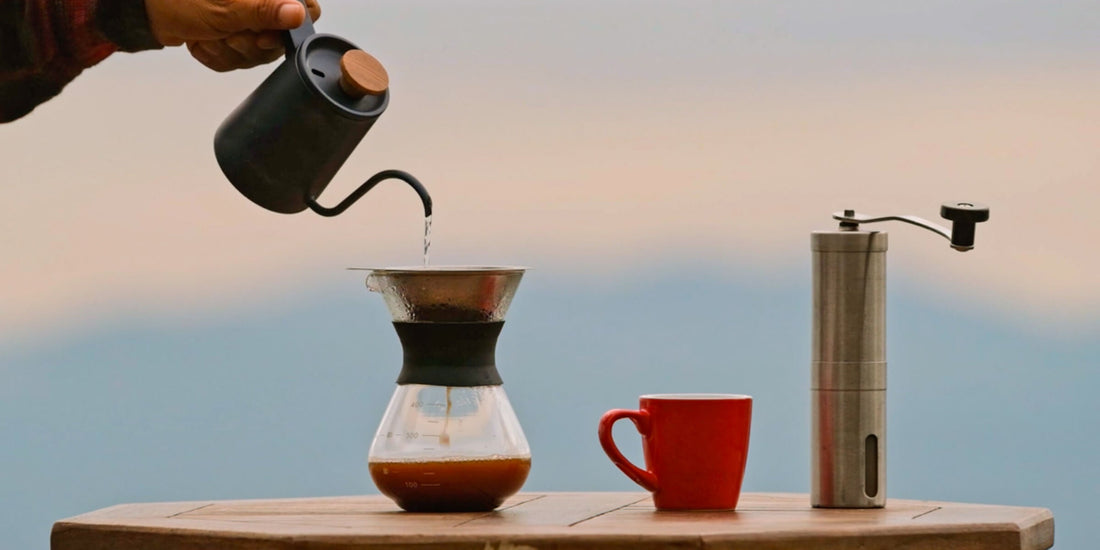Why does coffee from your favourite café taste so much richer and smoother than what you brew at home? It's a question many of us ask — and the answer isn't just "better machines" or "professional baristas." The secret lies in consistency, attention to detail, and a few key habits you can easily bring into your own kitchen.
At Terra Coffee & Tea, we've been roasting coffee since 1978. We've taught everyone from home enthusiasts to professional baristas how to make coffee shine — and we've seen firsthand that café-level results are possible at home. In this guide, you'll learn how to make coffee at home with simple steps that elevate your cup. By focusing on beans, grind size, water, and technique, you'll discover how to brew coffee that delights your senses every time.
How to Make Coffee at Home (The Right Way)
The brewing process isn't about perfection or expensive gear. It's about understanding how small changes — freshness, grind size, water quality — make big differences. Let's explore each of the seven essentials.
1. Start with Freshly Roasted Beans
- Coffee is at its peak within two weeks of roasting. After that, flavours fade and aromas flatten.
- Buy from local roasters or trusted sources who roast in small batches. Terra's coffees are roasted to order, meaning they leave our roastery in Montréal only when they're fresh.
- Choose single-origin coffees for distinctive flavour notes (like fruity Ethiopian or nutty Colombian) or blends for long-term taste profile consistency.
💡 Tip: If you've only ever bought pre-ground supermarket coffee, switching to fresh roasted whole beans is the single most impactful upgrade you can make toward the perfect cup of coffee.

2. Grind Just Before Brewing
Grinding exposes coffee's delicate compounds to oxygen. Within minutes, ground coffee begins losing flavour. That's why grinding just before brewing is key to brewing good coffee at home.
- Burr grinders (manual or electric) provide even results. Blade grinders chop unevenly, leading to over- or under-extraction.
- Adjust your grind size for your brew method — too fine ground coffee can make espresso harsh, while too coarse leaves french press coffee weak.
💡 Investing in a reliable burr grinder often improves your results more than buying a pricier coffee maker.
3. Match Grind Size to Brewing Method
One of the most common mistakes at home is using the wrong grind size. Here's a quick coffee grind size guide:
- Espresso → Extra fine, almost powdery. Creates the resistance needed for pressure extraction.
- Drip coffee makers → Medium, like sand. Ensures water flows evenly through the filter basket and paper filter.
- Pour over methods → Medium-fine, similar to table salt. Balances clarity and sweetness when pouring hot water over the grounds.
- French Press → Coarse, like breadcrumbs. Prevents muddy texture when steeped in cold water or hot water.
💡 Tip: Keep a small jar of correctly ground coffee from your favourite café as a reference. Compare the texture whenever you're adjusting your grinder at home.

4. Use the Right Water Temperature
Water is 98% of your brew, so it matters. Too hot, and your coffee tastes burnt. Too cool, and it's under-extracted.
- Ideal range: 94–96°C, just below the boiling point.
- Boil your kettle, then let it sit for 30–45 seconds before pouring if it doesn't have a temperature setting.
- Filtered water makes a difference — your water supply matters since chlorine or heavy minerals can mask flavours.
💡 For consistency, many home brewers invest in an electric kettle with a quality heating element and temperature control. It's an affordable step that pays off daily.
5. Measure Your Coffee and Water
Eyeballing your scoops leads to inconsistent results. Professional cafés weigh everything — and you can too.
- Golden ratio: 1:16 (1 gram of coffee for every 16 grams of water) is a common guideline for balanced flavour — but brew method matters.
- Espresso (double shot): Use 16–20 g of extra fine ground coffee to yield about 60 mL of espresso.
- Drip coffee: Use 8.5 g of medium-ground coffee for every 236.56 mL (8 oz) of water — ideal for freshly and properly roasted coffee.
No scale? 1 level tablespoon of fine-to medium-ground coffee is equivalent to about 4-5 grams. Adding more coffee is fine, but using less than the minimum will cause bitterness due to over-extraction.
💡 Tip: Once you find a recipe you love, stick with it. Consistency is the secret behind your barista's "always perfect" brew.
6. Invest in Quality Equipment
The best coffee maker for home isn't necessarily the most expensive — it's the one that fits your taste and style.
- Traditional espresso machines deliver café-style drinks but require practice.
- Pour-over brewers (like V60 or Chemex) highlight complex flavours and often use a stainless steel or paper filter.
- French press coffee creates a rich, full-bodied cup with minimal fuss.
- Automatic drip coffee makers are convenient but choose carefully — not all heat water to the right temperature or circulate it evenly through the filter basket.
At Terra, we recommend our Terra Pour-Over Coffee Maker for a balance of simplicity and flavour clarity.
💡 Tip: Even the hottest home coffee maker won't shine without good beans and the right grind — gear and ingredients go hand in hand. See our blog for top picks recommended by every coffee expert on our team.
7. Don't Forget Freshness
How you store your coffee can make or break your results.
- Keep beans in an airtight, opaque container - or packaging with an aluminum lining - away from light and moisture.
- Store in a freezer to preserve freshness the longest.
- Buy smaller amounts more often. It's better to restock monthly than buy a large bag that goes stale.
💡 Tip: Consider a vacuum-sealed container — it extends freshness and keeps aromas intact.
Common Questions Answered
How to Make Good Coffee at Home?
It starts with quality beans, proper grind, clean water, and consistent ratios. Even the best at home coffee maker can't fix stale beans or poor technique.
What Temperature Water for Coffee?
Stick to 90–96°C, just shy of the boiling point. Going outside this range is the fastest way to ruin flavour.
What's the Best Way to Brew Coffee at Home?
There's no single answer — it depends on your taste and routine.
- Prefer bold, café-style drinks? Try espresso.
- Love clean, bright notes? Go with pour over methods.
- Want easy and forgiving? French press coffee is your friend.
💡 Explore our brewing guides for step-by-step methods tailored to each style.
Terra's Perspective on Brewing Better Coffee
Since 1978, our family business has sourced green coffee beans directly from farmers who share our values. Our TAG roasting method (Torrefazione Artigianale Granito) caramelizes natural sugars in each bean, highlighting its unique origin. But the final step is always in your hands — how you brew at home.
When you take time to grind, measure, and brew with intention, you're not just making a drink. You're connecting with the farmer who nurtured the crop, the roaster who unlocked its potential, and the traditions that make coffee a global ritual.
Conclusion
Brewing café-quality coffee at home is about embracing small but meaningful habits: fresh beans, the right grind size, correct water temperature, and proper equipment. With these seven tips, you'll discover just how much joy a thoughtfully prepared cup can bring.
Ready to put these steps into practice? Try them with our freshly roasted coffees, explore new brewing methods, and turn your kitchen into your own café.


